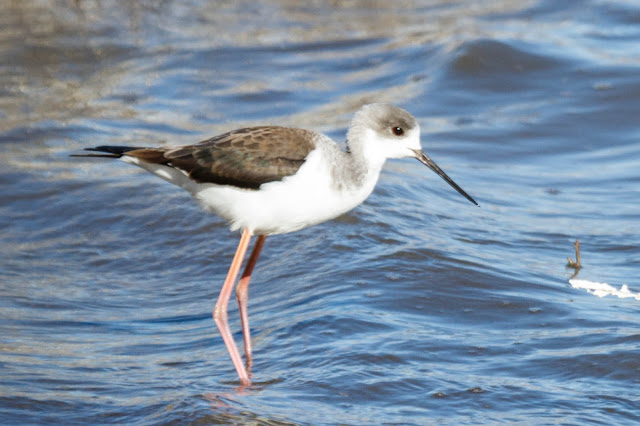So, whilst I was waiting patiently, nerves all on edge, to lie back on the operating chair and have the cataract removed frm my left eye, dreaming dreams about the wonderful birds I will be able to see in the New Year, Dave and his merry bank of followers were out and about in Cabo de Gata actually looking at our feathered fiends. And judging by Dave's report below if looks very much as if they did, indeed, have a good day's birding. But just think of the birds I was dreaming about! Ah well, soon be my turn again. To Dave and all his Arboleas Birding Group may I wish a very peaceful Christmas and a most happy and healthy New Year with lots of great birding to come.
Cabo de Gata & Rambla Morales:Wednesday 20th December
"The
early bird catches the worm", is the saying. So, as Gilly was
recovering from a bad back, I headed early to Cabo de Gata to "do" the
rear of the reserve before meeting up with the others from the group. I
got to the far end of the beach, seeing a flying Raven on the way, just
after the breaking dawn. The sun had not yet shown itself over the
mountains and there was a definite chill in the air! The first bird I
saw was a male Stonechat, closely followed by a Crested Lark, but the
salinas at this end were devoid of birdlife.
As I approached the defunct
hide, I started to see some birds. Some Shelduck and Greater Flamingo
in the water. Ringed Plover, Dunlin, Little Stint, Avocet and Black
Winged Stilt on the edges. There was a Kestrel on the ruined building
and I could hear a Red-legged Partridge. Beyond the hide I added a Black-necked Grebe plus Meadow Pipit, Greenfinch and White Wagtail. I then
found "the worm"! Four Common Crane nervously standing there. By this
time the sun had appeared over the mountain ridge so was able to get
some photos. Carrying on, I added an Iberian Grey Shrike high up on the
power lines and an obliging Corn Bunting on a bush. Nearing the end farm
buildings I saw a flock of Goldfinch plus House Sparrow and Collared
Dove. I got to the Pujaire cafe with 15 minutes to spare, so was
enjoying my coffee and tostada as the others started to arrive. I was
joined by Kevin and Troy, their friends, Pete and Sue, Les, scribe
again Val and Carolyn, having finished her season on the Isle of
Easedale, near Mull, Scotland doing Sea Safaris, seeing lots of White-tailed and Golden Eagles as well as seals and porpoises, not that
we're jealous of course!
 |
| Male Stonechat Saxicola torquatus (PHOTO: David Elliott-Binns) |
Suitably
refreshed we headed our way to the first hide. The usual suspects were
in the water. Greater Flamingo, Avocet, Mallard as well as a small group
of Black-tailed Godwit. There were a few Redshank and Grey Plover
spotted. An Eurasian Curlew was on the causeway. A warbler was flitting
around the shrubs in front of us. Les managed to ID it as a Dartford.
Carolyn then found a Marsh Harrier and I, in John's absence, found a
group of distant Spoonbill. Les counted 13 in all. There were 3 Iberian
Grey shrike perched behind us and I found a female Blue Rock Thrush on
the corner of the pumping station(?). Also seen were Chiffchaff, White
Wagtail, Collared Dove, Spotless Starling, Greenfinch, Crag Martin,
House Sparrow and Sardinian Warbler.
Moving
to the beach by the second hide we had Cormorant and Yellow-legged
Gull. I spotted an adult Gannet out to sea. I missed the flying group of
Stone Curlew as I'd locked on to the Marsh Harrier that
presumably spooked them! We also had Black-headed Gull, Raven, Kestrel
and numerous distant Black-necked Grebes. We had better views of the
always asleep Spoonbill, but no sign of the Common Cranes which would
have been opposite this location. As we were about to walk back to the
vehicles a flight of 21 Golden Plover passed by.
At
the public hide we added Black-winged Stilt, Dunlin, Sanderling,
Kentish and Little Ringed Plover. There was a long line of Lesser -black Backed Gulls as well as a few Sandwich Terns and a pair of
slightly pink Slender-billed Gulls.
It
being too early for lunch we convoyed our way along the beachside track
to the Rambla Morales. There were a few Cormorants resting at one end,
but birds were few and far between. I spotted a male Pintail and Les, a
female White Headed Duck. Troy and Carolyn found a small flock of
Greenfinch, but the only other birds were Moorhen, Coot and Mallard.
We then retired to the Cabo village beach cafe where we had a snack
lunch.
Lovely day in great company. 50 species for the day. I'm sure everyone will join Gilly and I in wishing you a Merry Christmas and a Happy New Year with great birding in 2018.
Best wishes and good health, Dave
Interstingly, when viting Cabo de Gata at the beginning of the month we, too, saw Common Crane and pronbably four as far as I rmember. Departing the water and over-flying the road above the first hide on the bend as you approach the village.
Check out the accompanying website at http://www.birdingaxarquia.weebly.com for the latest sightings, photographs and additional information




























































